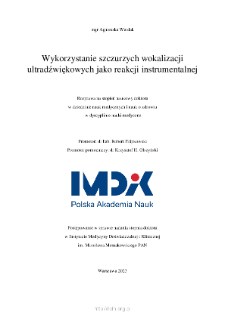- Search in all Repository
- Literature and maps
- Archeology
- Mills database
- Natural sciences
Advanced search
Advanced search
Advanced search
Advanced search
Advanced search

Object
Title: Wykorzystanie szczurzych wokalizacji ultradźwiękowych jako reakcji instrumentalnej
Institutional creator:
Instytut Medycyny Doświadczalnej i Klinicznej im. Mirosława Mossakowskiego PAN
Contributor:
Filipkowski, Robert (Promotor) ; Olszyński, Krzysztof H. (Promotor pomocniczy)
Place of publishing:
Degree name:
Level of degree:
Degree discipline :
Degree grantor:
Instytut Medycyny Doświadczalnej i Klinicznej im. M. Mossakowskiego PAN
Type of object:
Abstract:
Rats being social animals express many behaviors that regulate their functioning in a group environment. A very important aspects of intraspecific rat communication are ultrasonic vocalizations (USV). The widely accepted consensus is that USV can be divided into two main groups. First are the 22-kHz calls which are often associated with aversive situations; therefore, they express an internal negative state of the animal. The second group of USV are 50-kHz calls which are associated with the rat’s positive emotional state. The aim of the study was to develop a protocol of operant conditioning using emission of rat 50-kHz USV as operant response. The results showed that all rats analyzed as a one group did not learn in operant conditioning to vocalize in order to receive a reward. Also, control experiments done in parallel demonstrated that rats previously reinforced for USV emission readily acquired nose-pokes as operant responses. As a result of further analysis, two groups of animals emerged depending on the efficacy of operant USV-learning. A minority of rats (n = 15) that were rewarded for 50-kHz USV emission were considered as potentially-learning based on an arbitrary criterion. Majority of rats (n = 61) were considered as non-learning. The potentially-learning rats have shown some changes in behavior which suggested the emergence of an associative process and reinforcement of emission of 50-kHz calls. These changes in behavior could have been the consequence of using the above-mentioned criterion. However, a number of changes in potentially-learning rats were described, which indicated the occurrence of learning and did not result directly from the adopted criterion. Potential reasons of why USV may not easily become an operant response are extensively discussed in the Discussion. The introduction of operant conditioning protocol with rat USV as operant response could become a very useful tool to study rat USV and animal models of human neurological diseases.
Detailed Resource Type:
Format:
Resource Identifier:
Source:
IMDiK PAN, sygn. ZS 431 ; click here to follow the link
Language of abstract:
Rights:
Creative Commons Attribution BY 4.0 license
Terms of use:
Copyright-protected material. [CC BY 4.0] May be used within the scope specified in Creative Commons Attribution BY 4.0 license, full text available at: ; -
Digitizing institution:
Mossakowski Medical Research Institute PAS
Original in:
Library of the Mossakowski Medical Research Institute PAS
Projects co-financed by:
Access:
Object collections:
- Digital Repository of Scientific Institutes > Partners' collections > Mossakowski Medical Research Institute PAS > Theses > Ph.D Dissertationes
- Digital Repository of Scientific Institutes > Literature > Thesis
Last modified:
Nov 18, 2024
In our library since:
Dec 28, 2023
Number of object content downloads / hits:
83
All available object's versions:
https://rcin.org.pl./publication/276495
Show description in RDF format:
Show description in RDFa format:
Show description in OAI-PMH format:
| Edition name | Date |
|---|---|
| Wardak,Agnieszka,2023,Wykorzystanie szczurzych wokalizacji ultradźwiękowych jako reakcji instrumentalnej | Nov 18, 2024 |

 INSTYTUT ARCHEOLOGII I ETNOLOGII POLSKIEJ AKADEMII NAUK
INSTYTUT ARCHEOLOGII I ETNOLOGII POLSKIEJ AKADEMII NAUK
 INSTYTUT BADAŃ LITERACKICH POLSKIEJ AKADEMII NAUK
INSTYTUT BADAŃ LITERACKICH POLSKIEJ AKADEMII NAUK
 INSTYTUT BADAWCZY LEŚNICTWA
INSTYTUT BADAWCZY LEŚNICTWA
 INSTYTUT BIOLOGII DOŚWIADCZALNEJ IM. MARCELEGO NENCKIEGO POLSKIEJ AKADEMII NAUK
INSTYTUT BIOLOGII DOŚWIADCZALNEJ IM. MARCELEGO NENCKIEGO POLSKIEJ AKADEMII NAUK
 INSTYTUT BIOLOGII SSAKÓW POLSKIEJ AKADEMII NAUK
INSTYTUT BIOLOGII SSAKÓW POLSKIEJ AKADEMII NAUK
 INSTYTUT CHEMII FIZYCZNEJ PAN
INSTYTUT CHEMII FIZYCZNEJ PAN
 INSTYTUT CHEMII ORGANICZNEJ PAN
INSTYTUT CHEMII ORGANICZNEJ PAN
 INSTYTUT FILOZOFII I SOCJOLOGII PAN
INSTYTUT FILOZOFII I SOCJOLOGII PAN
 INSTYTUT GEOGRAFII I PRZESTRZENNEGO ZAGOSPODAROWANIA PAN
INSTYTUT GEOGRAFII I PRZESTRZENNEGO ZAGOSPODAROWANIA PAN
 INSTYTUT HISTORII im. TADEUSZA MANTEUFFLA POLSKIEJ AKADEMII NAUK
INSTYTUT HISTORII im. TADEUSZA MANTEUFFLA POLSKIEJ AKADEMII NAUK
 INSTYTUT JĘZYKA POLSKIEGO POLSKIEJ AKADEMII NAUK
INSTYTUT JĘZYKA POLSKIEGO POLSKIEJ AKADEMII NAUK
 INSTYTUT MATEMATYCZNY PAN
INSTYTUT MATEMATYCZNY PAN
 INSTYTUT MEDYCYNY DOŚWIADCZALNEJ I KLINICZNEJ IM.MIROSŁAWA MOSSAKOWSKIEGO POLSKIEJ AKADEMII NAUK
INSTYTUT MEDYCYNY DOŚWIADCZALNEJ I KLINICZNEJ IM.MIROSŁAWA MOSSAKOWSKIEGO POLSKIEJ AKADEMII NAUK
 INSTYTUT PODSTAWOWYCH PROBLEMÓW TECHNIKI PAN
INSTYTUT PODSTAWOWYCH PROBLEMÓW TECHNIKI PAN
 INSTYTUT SLAWISTYKI PAN
INSTYTUT SLAWISTYKI PAN
 SIEĆ BADAWCZA ŁUKASIEWICZ - INSTYTUT TECHNOLOGII MATERIAŁÓW ELEKTRONICZNYCH
SIEĆ BADAWCZA ŁUKASIEWICZ - INSTYTUT TECHNOLOGII MATERIAŁÓW ELEKTRONICZNYCH
 MUZEUM I INSTYTUT ZOOLOGII POLSKIEJ AKADEMII NAUK
MUZEUM I INSTYTUT ZOOLOGII POLSKIEJ AKADEMII NAUK
 INSTYTUT BADAŃ SYSTEMOWYCH PAN
INSTYTUT BADAŃ SYSTEMOWYCH PAN
 INSTYTUT BOTANIKI IM. WŁADYSŁAWA SZAFERA POLSKIEJ AKADEMII NAUK
INSTYTUT BOTANIKI IM. WŁADYSŁAWA SZAFERA POLSKIEJ AKADEMII NAUK


































